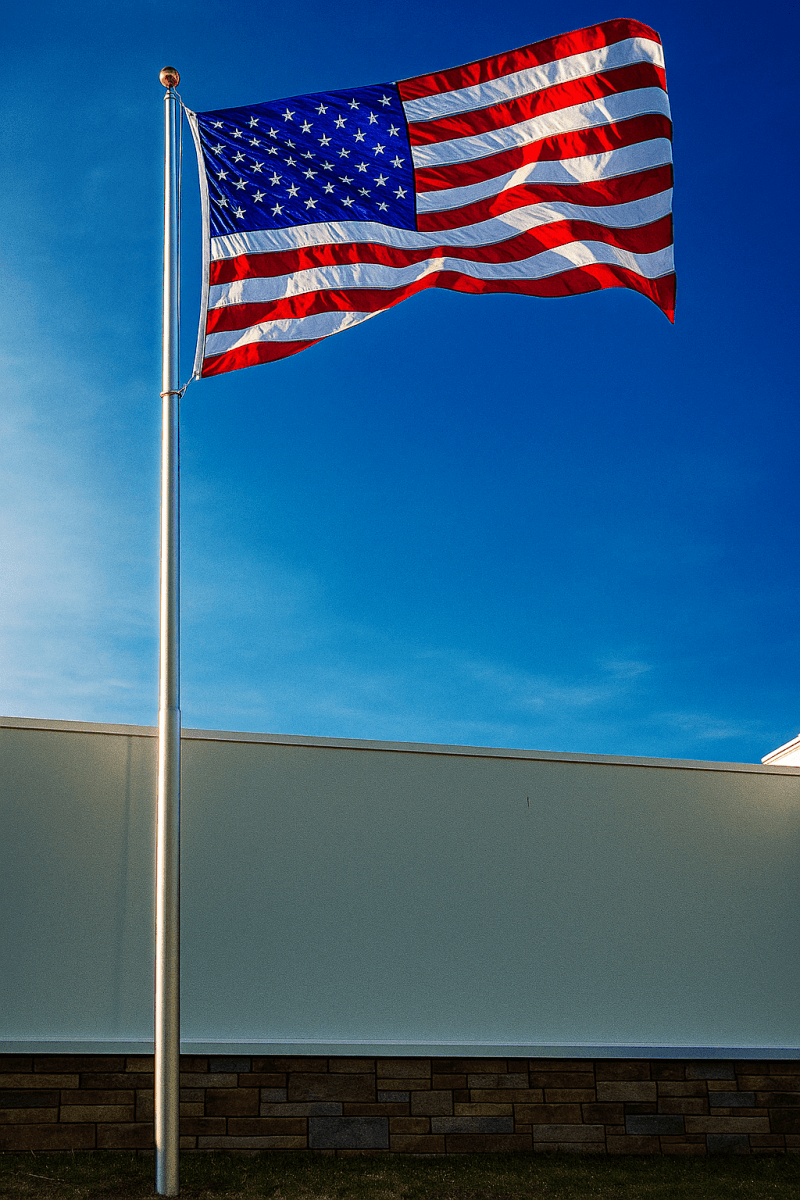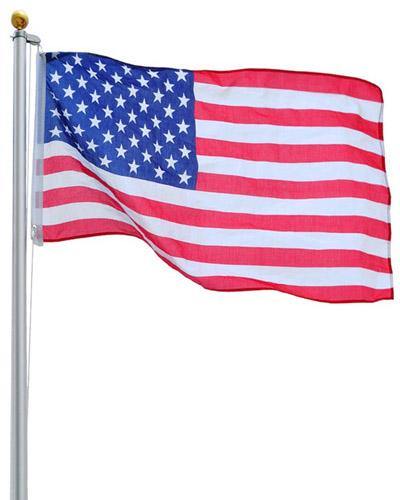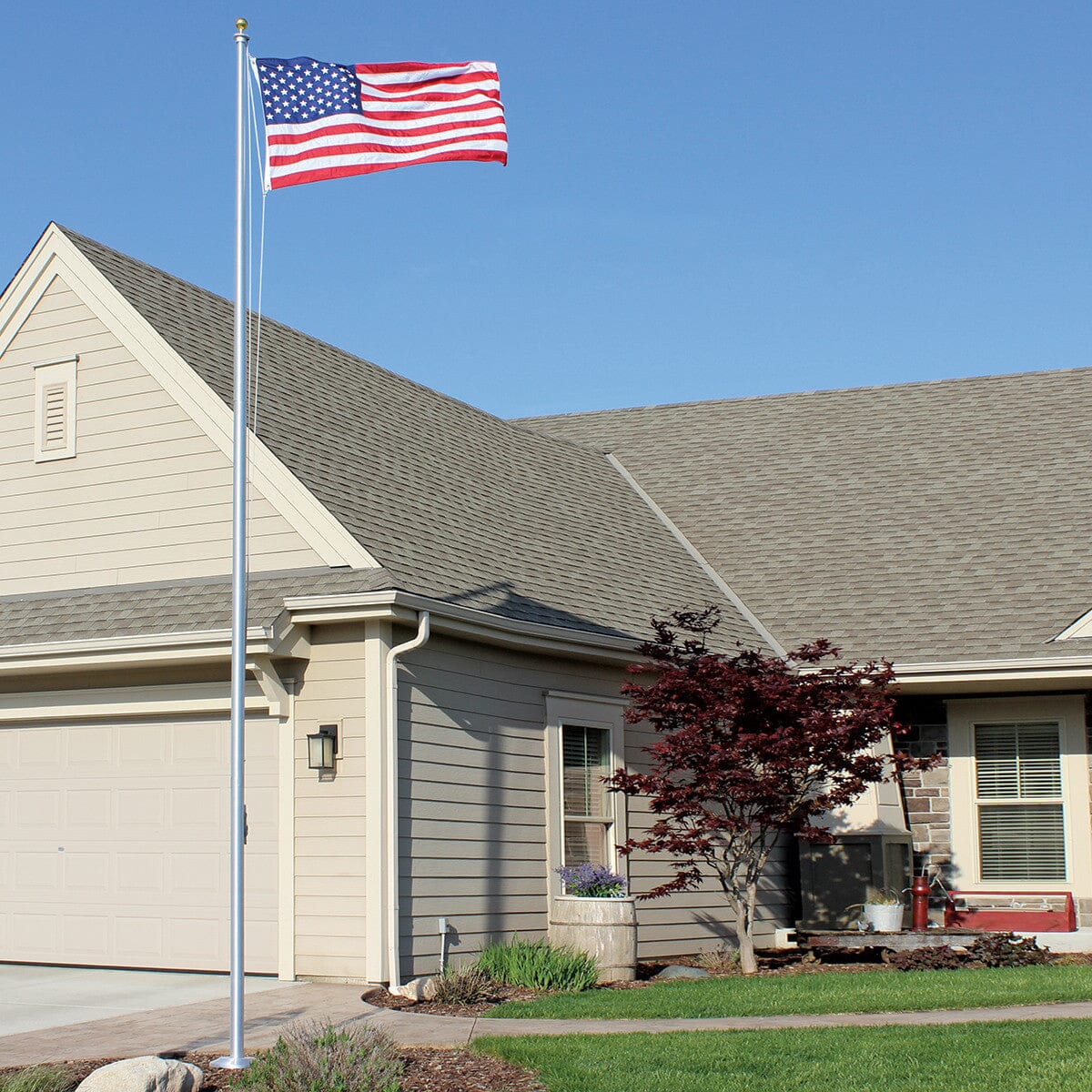Flying a flag at your home or business shows pride, patriotism, and respect. But a flagpole is only as strong as its installation. A poorly mounted flagpole can become a safety risk and an eyesore. That’s why it’s essential to install it the right way.
In this guide, we’ll show you how to properly secure a heavy-duty wall-mounted flagpole, from choosing the right location and tools to step-by-step instructions and maintenance tips. Let’s make sure your flag flies high, proud, and secure for years to come.
Choosing the Right Location
Choose a spot where your flag is clearly visible and makes a strong statement. Check the area from different angles, and avoid obstacles such as gutters, overhangs, or tree branches that could tangle or tear the flag. Steer clear of electrical wiring to prevent safety hazards.
Wind exposure matters—while a steady breeze helps the flag fly, constant strong winds can strain the mount and damage the wall over time.
Wall material also plays a key role. Brick offers strong support when properly anchored. With vinyl siding, anchor directly into studs or sheathing, as the siding itself isn’t structural. Stucco can work, but it requires careful drilling to avoid cracks and to ensure anchors reach solid framing. Whatever the surface, always secure the mount to a stable anchor point that can handle both weight and wind.
Preinstallation Checklist
Before you begin the installation, gather the necessary tools and materials, and review safety procedures. This will make the process smoother and safer.
Tools and Materials You’ll Need
To properly secure the mount, you will need a drill powerful enough for your wall surface. Select masonry bits for brick or stucco and wood bits for siding or wooden structures. You will also need the appropriate fasteners, such as lag bolts for wood or expansion anchors for masonry. A level is essential to ensure the mount is perfectly straight. Have a wrench or a socket set handy to tighten the bolts securely. Since you will likely be working at a height, a sturdy ladder is a must.
Safety First
Always wear proper personal protective equipment, including safety goggles to shield your eyes from debris and gloves to protect your hands. When working on a ladder, ensure it is placed on level ground and that you maintain three points of contact at all times. Understand your own limits; if you feel uncomfortable with the height or the complexity of the task, do not hesitate to call a professional. A job done safely is a job done well.

Step-by-Step: Securing the Flagpole Mount
With your location chosen and your tools ready, it is time to secure the flagpole mount to the wall. Following these steps carefully will ensure a stable and lasting installation.
Marking Your Mounting Holes
Position the flagpole bracket on the wall, and use a level to ensure it is perfectly horizontal or vertical, depending on its design. A straight mount is critical for the flag to hang correctly and look its best. Once the bracket is aligned, use a pencil or marker to mark the center of each mounting hole directly onto the wall. Mark all holes before you start drilling to guarantee accurate placement.
Drilling Into the Wall
Choose a drill bit that matches the diameter of your fasteners. When drilling into masonry, use the hammer drill setting, if available, to make the process easier. Drill each hole to the required depth for your anchors or bolts. Try to keep the drill perpendicular to the wall to create a straight path for the fastener, which will provide a stronger hold.
Inserting Anchors or Bolts
The choice between lag bolts and expansion anchors depends on your wall surface. Use lag bolts for wood-framed walls, driving them directly into the studs for maximum strength. For brick or concrete, use expansion anchors, which expand inside the hole to create a tight, secure grip. Insert the anchor into the drilled hole, and then drive the bolt through the bracket into the anchor. Tighten the bolts gradually, but be careful not to overtighten, as this can strip the threads or crack the wall material.
Mounting the Flagpole Bracket
After you have drilled the holes and placed the anchors, you can now attach the bracket.
Align and Attach
Line up the bracket with the holes you prepared. Hand-tighten all the bolts or screws first to hold the bracket in place. This allows you to make minor adjustments to the alignment before fully securing it. Once you are satisfied with the position, use your wrench or socket set to tighten the bolts firmly. It is a good idea to check the alignment one last time with your level after the initial tightening.
Double-Check for Stability
After securing the bracket, test its stability by giving it a firm shake. A properly installed wall-mounted flagpole should show no movement or wobble at the mount. If you notice any looseness, tighten the bolts further, or switch to larger fasteners for added support. A solid bracket is key to a safe, long-lasting installation.
Attaching and Flying Your Flag
The final steps involve placing the flagpole into the bracket and attaching your flag.
Installing the Pole in the Bracket
Slide the flagpole into the bracket, ensuring it is positioned correctly. Many brackets have set screws that you must tighten to hold the pole firmly in place and prevent it from rotating or slipping out, especially in high winds. Make sure these screws are snug.
Flag Size and Weight Considerations
For a heavy-duty mount, you can typically use a larger flag, but always adhere to the manufacturer’s recommendations. Using a flag that is too large or heavy can put excessive strain on the bracket and the wall, risking damage. Choose a flag size that is proportionate to your flagpole and suitable for the strength of your installation.

Maintenance and Long-Term Care
Proper installation is just the beginning. Regular maintenance will ensure your flagpole remains secure and your flag continues to fly proudly. Once you have properly secured your heavy-duty wall-mounted flagpole, you must keep it in top shape.
Inspecting the Mount
Periodically inspect the flagpole mount, especially after severe weather. Check for any signs of rust, corrosion, or cracking. Ensure all bolts are still tight and that there is no movement in the bracket. A quick inspection a few times a year can prevent major issues down the road.
Weather Readiness
On days with extremely high winds, it is wise to lower or remove your flag to reduce the strain on the mount. In regions prone to hurricanes or other severe weather, taking down the flag and even the pole is a necessary precaution. Be mindful of seasonal changes that might affect the installation.
Final Thoughts
A properly secured wall-mounted flagpole does not just hold up Old Glory; it stands as a symbol of strength, respect, and enduring patriotism. The honor of flying the flag comes with the responsibility to do so safely and correctly. By taking your time, using the right tools, and following the steps outlined in this guide, you ensure that your flag will fly with the dignity it represents. This installation is a tribute to the values you cherish, built to last and to inspire all who see it.







